�
Chaos Engineering
Building Confidence in System Behavior
through Experiments
Casey Rosenthal, Lorin Hochstein,
Aaron Blohowiak, Nora Jones, and
Ali Basiri
Beijing
Beijing
Boston
Boston
Farnham Sebastopol
Farnham Sebastopol
Tokyo
Tokyo
Chaos Engineering
by Casey Rosenthal, Lorin Hochstein, Aaron Blohowiak, Nora Jones, and Ali Basiri
Copyright © 2017 Netflix, Inc. All rights reserved.
Printed in the United States of America.
Published by O’Reilly Media, Inc., 1005 Gravenstein Highway North, Sebastopol, CA
95472.
O’Reilly books may be purchased for educational, business, or sales promotional use.
Online editions are also available for most titles (http://oreilly.com/safari). For more
information, contact our corporate/institutional sales department: 800-998-9938 or
corporate@oreilly.com.
Editor: Brian Anderson
Production Editor: Colleen Cole
Copyeditor: Christina Edwards
Interior Designer: David Futato
Cover Designer: Karen Montgomery
Illustrator: Rebecca Demarest
August 2017:
First Edition
Revision History for the First Edition
2017-08-15: First Release
The O’Reilly logo is a registered trademark of O’Reilly Media, Inc. Chaos Engineer‐
ing, the cover image, and related trade dress are trademarks of O’Reilly Media, Inc.
While the publisher and the authors have used good faith efforts to ensure that the
information and instructions contained in this work are accurate, the publisher and
the authors disclaim all responsibility for errors or omissions, including without
limitation responsibility for damages resulting from the use of or reliance on this
work. Use of the information and instructions contained in this work is at your own
risk. If any code samples or other technology this work contains or describes is sub‐
ject to open source licenses or the intellectual property rights of others, it is your
responsibility to ensure that your use thereof complies with such licenses and/or
rights.
978-1-491-95306-8
[LSI]
�
Table of Contents
Part I.
Introduction
1. Why Do Chaos Engineering?. . . . . . . . . . . . . . . . . . . . . . . . . . . . . . . . . . 3
How Does Chaos Engineering Differ from Testing? 3
It’s Not Just for Netflix 5
Prerequisites for Chaos Engineering 6
2. Managing Complexity. . . . . . . . . . . . . . . . . . . . . . . . . . . . . . . . . . . . . . . 9
Understanding Complex Systems 10
Example of Systemic Complexity 13
Takeaway from the Example 15
Part II.
The Principles of Chaos
3. Hypothesize about Steady State. . . . . . . . . . . . . . . . . . . . . . . . . . . . . 21
Characterizing Steady State 24
Forming Hypotheses 25
4. Vary Real-World Events. . . . . . . . . . . . . . . . . . . . . . . . . . . . . . . . . . . . 29
5. Run Experiments in Production. . . . . . . . . . . . . . . . . . . . . . . . . . . . . . 35
State and Services 36
Input in Production 37
Other People’s Systems 37
Agents Making Changes 38
iii
�
External Validity 38
Poor Excuses for Not Practicing Chaos 39
Get as Close as You Can 40
6. Automate Experiments to Run Continuously. . . . . . . . . . . . . . . . . . 41
Automatically Executing Experiments 41
Automatically Creating Experiments 44
7. Minimize Blast Radius. . . . . . . . . . . . . . . . . . . . . . . . . . . . . . . . . . . . .
47
Part III.
Chaos In Practice
8. Designing Experiments. . . . . . . . . . . . . . . . . . . . . . . . . . . . . . . . . . . .
53
1. Pick a Hypothesis 53
2. Choose the Scope of the Experiment 54
3. Identify the Metrics You’re Going to Watch 54
4. Notify the Organization 55
5. Run the Experiment 56
6. Analyze the Results 56
7. Increase the Scope 56
8. Automate 56
9. Chaos Maturity Model. . . . . . . . . . . . . . . . . . . . . . . . . . . . . . . . . . . . . . 57
Sophistication 57
Adoption 59
Draw the Map 60
10. Conclusion. . . . . . . . . . . . . . . . . . . . . . . . . . . . . . . . . . . . . . . . . . . . . . . 63
Resources 63
iv
|
Table of Contents
�
PART I
Introduction
Chaos Engineering is the discipline of experimenting on a dis‐
tributed system in order to build confidence in the system’s capabil‐
ity to withstand turbulent conditions in production.
—Principles of Chaos
If you’ve ever run a distributed system in production, you know that
unpredictable events are bound to happen. Distributed systems con‐
tain so many interacting components that the number of things that
can go wrong is enormous. Hard disks can fail, the network can go
down, a sudden surge in customer traffic can overload a functional
component—the list goes on. All too often, these events trigger out‐
ages, poor performance, and other undesirable behaviors.
We’ll never be able to prevent all possible failure modes, but we can
identify many of the weaknesses in our system before they are trig‐
gered by these events. When we do, we can fix them, preventing
those future outages from ever happening. We can make the system
more resilient and build confidence in it.
Chaos Engineering is a method of experimentation on infrastruc‐
ture that brings systemic weaknesses to light. This empirical process
of verification leads to more resilient systems, and builds confidence
in the operational behavior of those systems.
�
Using Chaos Engineering may be as simple as manually running
kill -9 on a box inside of your staging environment to simulate
failure of a service. Or, it can be as sophisticated as automatically
designing and carrying out experiments in a production enviroment
against a small but statistically significant fraction of live traffic.
The History of Chaos Engineering at Netflix
Ever since Netflix began moving out of a datacenter into the cloud
in 2008, we have been practicing some form of resiliency testing in
production. Only later did our take on it become known as Chaos
Engineering. Chaos Monkey started the ball rolling, gaining notori‐
ety for turning off services in the production environment. Chaos
Kong transferred those benefits from the small scale to the very
large. A tool called Failure Injection Testing (FIT) laid the founda‐
tion for tackling the space in between. Principles of Chaos helped
formalize the discipline, and our Chaos Automation Platform is ful‐
filling the potential of running chaos experimentation across the
microservice architecture 24/7.
As we developed these tools and experience, we realized that Chaos
Engineering isn’t about causing disruptions in a service. Sure,
breaking stuff is easy, but it’s not always productive. Chaos Engi‐
neering is about surfacing the chaos already inherent in a complex
system. Better comprehension of systemic effects leads to better
engineering in distributed systems, which improves resiliency.
This book explains the main concepts of Chaos Engineering, and
how you can apply these concepts in your organization. While the
tools that we have written may be specific to Netflix’s environment,
we believe the principles are widely applicable to other contexts.
�
CHAPTER 1
Why Do Chaos Engineering?
Chaos Engineering is an approach for learning about how your sys‐
tem behaves by applying a discipline of empirical exploration. Just as
scientists conduct experiments to study physical and social phenom‐
ena, Chaos Engineering uses experiments to learn about a particular
system.
Applying Chaos Engineering improves the resilience of a system. By
designing and executing Chaos Engineering experiments, you will
learn about weaknesses in your system that could potentially lead to
outages that cause customer harm. You can then address those
weaknesses proactively, going beyond the reactive processes that
currently dominate most incident response models.
How Does Chaos Engineering Differ from
Testing?
Chaos Engineering, fault injection, and failure testing have a large
overlap in concerns and often in tooling as well; for example, many
Chaos Engineering experiments at Netflix rely on fault injection to
introduce the effect being studied. The primary difference between
Chaos Engineering and these other approaches is that Chaos Engi‐
neering is a practice for generating new information, while fault
injection is a specific approach to testing one condition.
When you want to explore the many ways a complex system can
misbehave, injecting communication failures like latency and errors
is one good approach. But we also want to explore things like a large
3
�
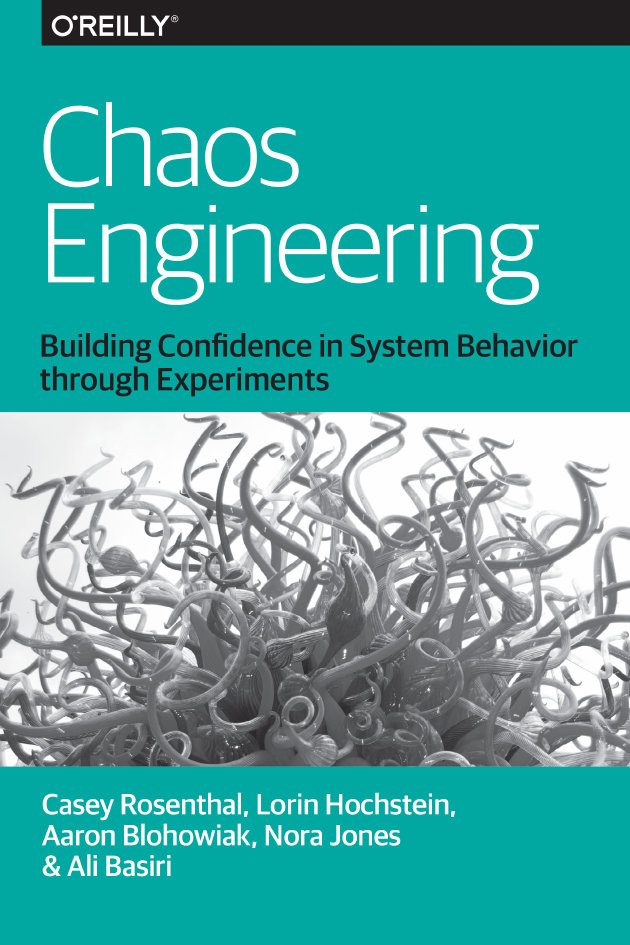
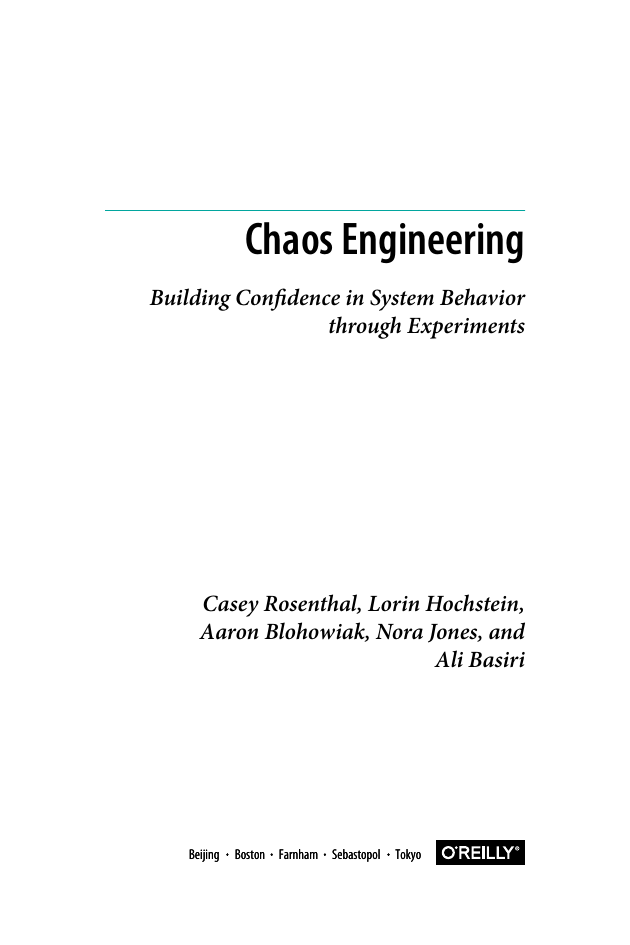
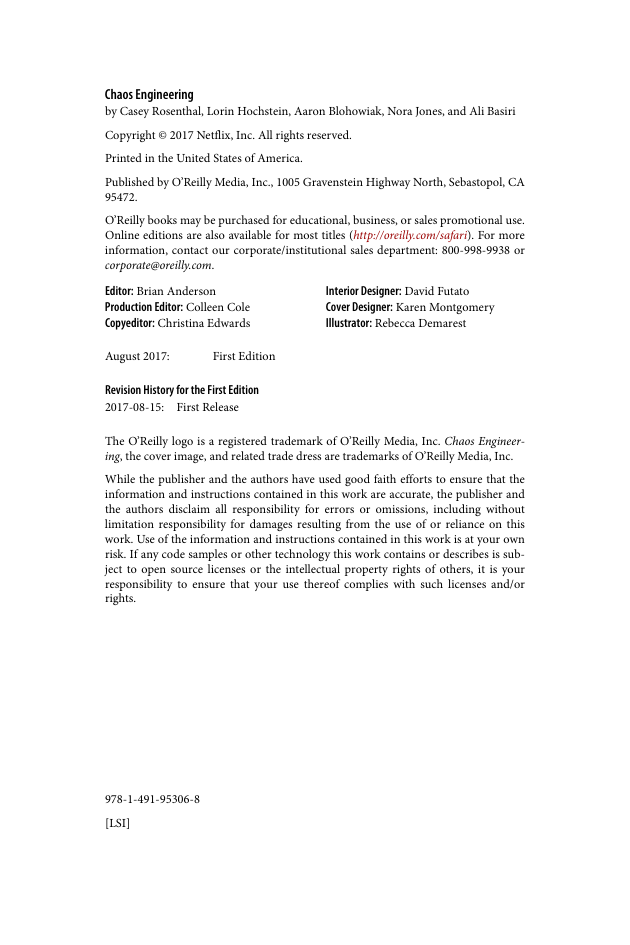
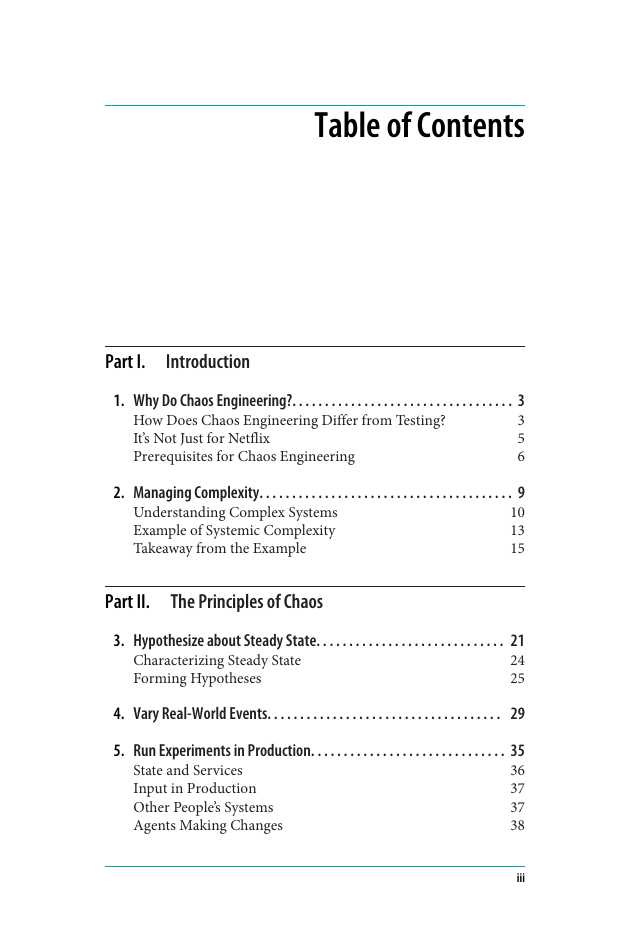
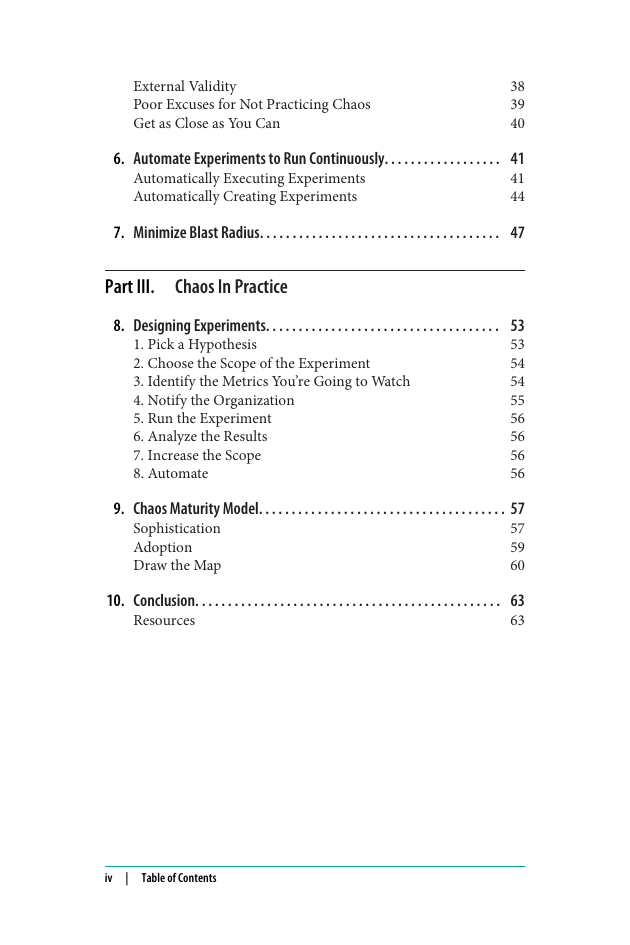
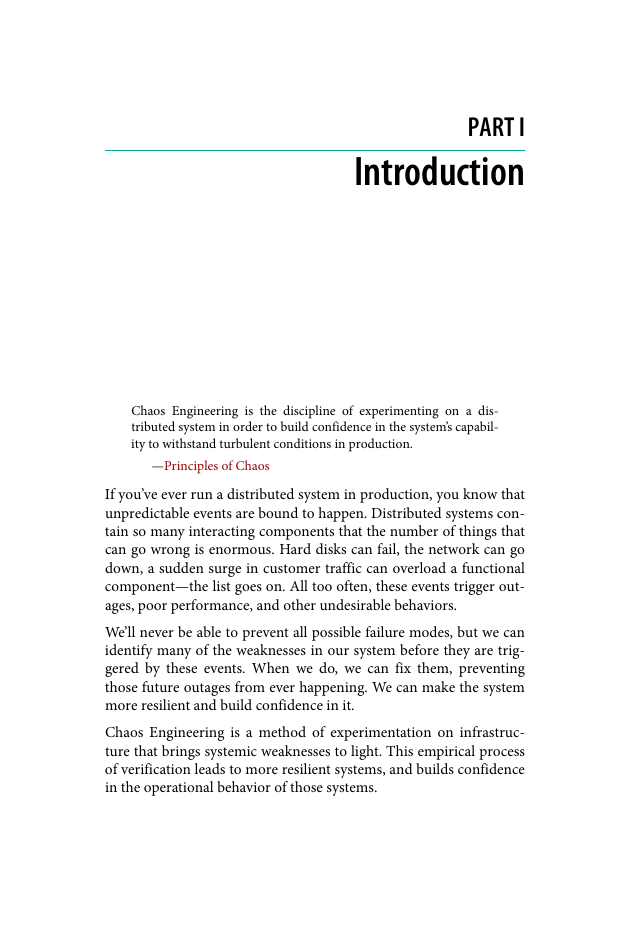
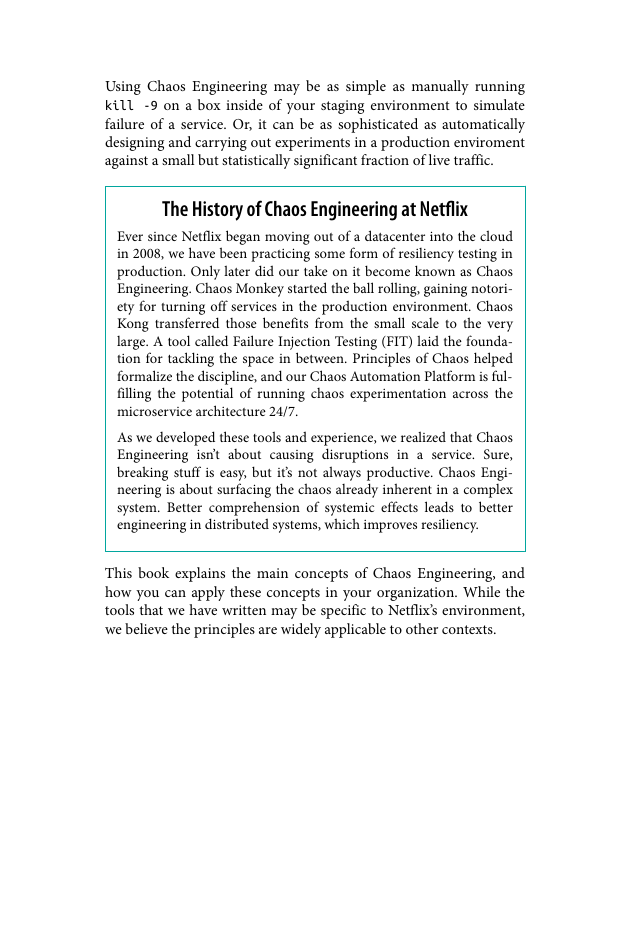
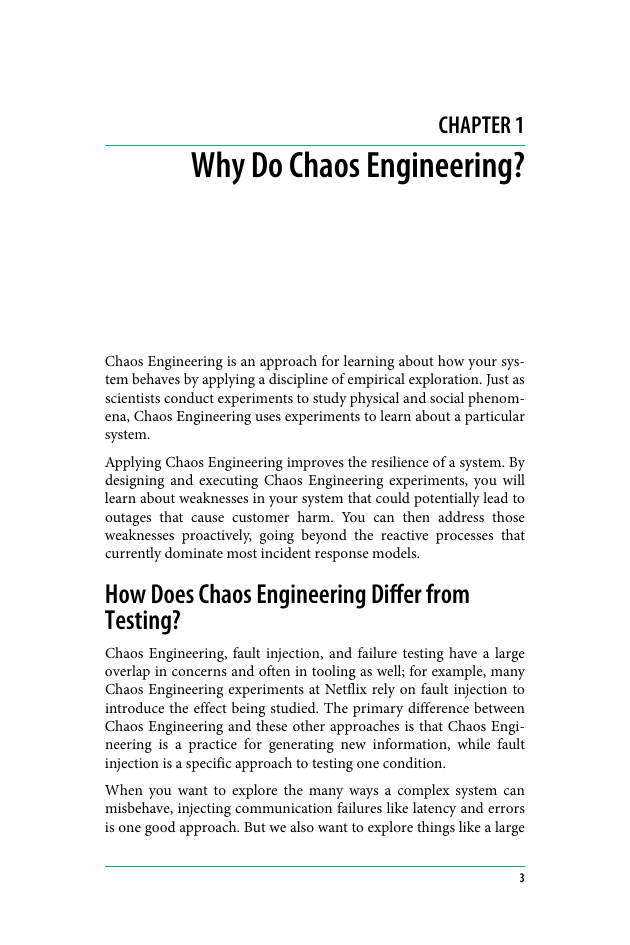








 2023年江西萍乡中考道德与法治真题及答案.doc
2023年江西萍乡中考道德与法治真题及答案.doc 2012年重庆南川中考生物真题及答案.doc
2012年重庆南川中考生物真题及答案.doc 2013年江西师范大学地理学综合及文艺理论基础考研真题.doc
2013年江西师范大学地理学综合及文艺理论基础考研真题.doc 2020年四川甘孜小升初语文真题及答案I卷.doc
2020年四川甘孜小升初语文真题及答案I卷.doc 2020年注册岩土工程师专业基础考试真题及答案.doc
2020年注册岩土工程师专业基础考试真题及答案.doc 2023-2024学年福建省厦门市九年级上学期数学月考试题及答案.doc
2023-2024学年福建省厦门市九年级上学期数学月考试题及答案.doc 2021-2022学年辽宁省沈阳市大东区九年级上学期语文期末试题及答案.doc
2021-2022学年辽宁省沈阳市大东区九年级上学期语文期末试题及答案.doc 2022-2023学年北京东城区初三第一学期物理期末试卷及答案.doc
2022-2023学年北京东城区初三第一学期物理期末试卷及答案.doc 2018上半年江西教师资格初中地理学科知识与教学能力真题及答案.doc
2018上半年江西教师资格初中地理学科知识与教学能力真题及答案.doc 2012年河北国家公务员申论考试真题及答案-省级.doc
2012年河北国家公务员申论考试真题及答案-省级.doc 2020-2021学年江苏省扬州市江都区邵樊片九年级上学期数学第一次质量检测试题及答案.doc
2020-2021学年江苏省扬州市江都区邵樊片九年级上学期数学第一次质量检测试题及答案.doc 2022下半年黑龙江教师资格证中学综合素质真题及答案.doc
2022下半年黑龙江教师资格证中学综合素质真题及答案.doc